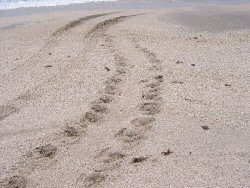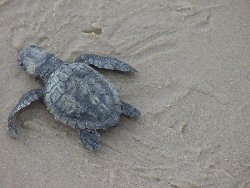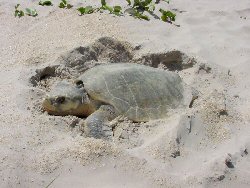INCREASING TURTLE NESTS ALONG THE TEXAS COAST
Mike Ray, Director of Field Operations, Coastal Fisheries Division
Thanks to three decades of sea turtle conservation in the U.S. and Mexico, your chances of actually seeing a sea turtle in the nearshore waters along the Texas coast are going up. The primary reasons for the increased sea turtle abundance are greater protection of nesting females and their eggs from predators and requiring the use of Turtle Excluder Devices in shrimp trawls. However, moralities resulting from a variety of human activities such as commercial fishing, industrial operations, and recreational boating and fishing remain a serious problem. Since human and sea turtle populations are both increasing along the Texas coast, it’s inevitable that encounters between the two will also increase, especially in the spring and summer months when nesting occurs.

The Kemp’s ridley, the most endangered sea turtle species, is the most common nester on Texas beaches. Last year, a record 40 sea turtle nests were documented in Texas -- 38 of them Kemp’s ridley nests. The range of nesting turtles seems to have increased beyond Padre Island as well. In 2002, biologists were pleasantly surprised that Kemp’s ridley nests were found as far north as Galveston Island. For beach visitors anywhere on the Texas coast, this means being on the look out for nesting sea turtles from April through August, but primarily during the peak months for nesting, May and June.

What should be done if you spot a sea turtle? First, protect the sea turtle from passing traffic. Believe it or not, a vehicle struck a nesting female last summer as she was attempting to return to the surf. Next, allow the sea turtle to nest undisturbed. Touching the turtle or even getting too close can disturb her enough to prevent her from laying her eggs. However take a photograph or video of the nesting sea turtle if you have a camera or camcorder available because the turtles may have markings that could identify her as a nester biologist have seen before. Then, mark where the turtle nested and stay at the site until assistance arrives if possible. Most importantly, immediately notify a beach official or call to report a sea turtle sighting at 1-866-TURTLE5 and follow the instructions on the recorded message. Remember: federal and state laws protect sea turtles, their eggs, hatchlings, and even the eggshells so please leave them alone.

Unfortunately, quite a few sea turtles are hooked each year by recreational anglers -- not a pleasant experience for any angler, and certainly not for the sea turtle. So what can you do to avoid hooking sea turtles in the first place? Don't fish in areas where sea turtles are surfacing to breathe or move to another location if you see one in the water. However, should a sea turtle get hooked or entangled in fishing line, try following these procedures. Gently move the turtle in close and use a dip net or a firm hold on the front flippers and shell to safely lift the turtle out of the water and place it on a stable working surface. Cut the line with blunt scissors or a knife close to the hook and remove any line that has become entangled around the turtle. Be very careful to avoid the turtle’s mouth and flipper claws because they can be quite aggressive and may use these weapons to defend themselves. Don't try to lift the turtle above the water by pulling on the line because this will further injure the turtle. If you cannot lift the turtle by hand, cut the line as close as possible to release the turtle. Do not remove the hook unless the turtle is lightly hooked and it can be taken out without injury to the turtle or you. If in doubt, leave the hook in the turtle. Turtles with serious cuts, swallowed or deeply embedded hooks need veterinary care. In this case, move the turtle to the shade and call 1-866-TURTLE5 to obtain assistance from a knowledgeable biologist.
Who would have thought 18 years ago when the Kemp's ridley turtle numbers were at their lowest, that the species could make a comeback. But with the work of many professionals and volunteers on Padre Island and on the Mexican coast their numbers are growing. A significant percentage of nesting sea turtle sightings on the beach are reported by beach visitors, so if you keep a watchful eye on the beach during windy days in May and June you might be one of the fortunate few to witness a Kemp’s ridley crawling from the surf to the base of the dunes to deposit a clutch of ping pong ball-sized eggs. If you do see the sea turtles or their tracks, please contact a beach official or call 1-866-TURTLE5.
© Copyright Texas Parks and Wildlife Department. No part of this work may be copied, reproduced, or translated in any form or medium without the prior written consent of Texas Parks Wildlife Department except where specifically noted. If you want to use these articles, see Site Policies